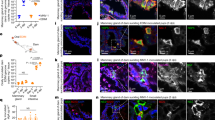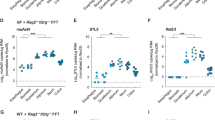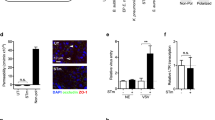Abstract
Human noroviruses (HuNoVs) are a leading cause of foodborne disease and severe childhood diarrhea, and they cause a majority of the gastroenteritis outbreaks worldwide. However, the development of effective and long-lasting HuNoV vaccines and therapeutics has been greatly hindered by their uncultivability. We recently demonstrated that a HuNoV replicates in human B cells, and that commensal bacteria serve as a cofactor for this infection. In this protocol, we provide detailed methods for culturing the GII.4-Sydney HuNoV strain directly in human B cells, and in a coculture system in which the virus must cross a confluent epithelial barrier to access underlying B cells. We also describe methods for bacterial stimulation of HuNoV B cell infection and for measuring viral attachment to the surface of B cells. Finally, we highlight variables that contribute to the efficiency of viral replication in this system. Infection assays require 3 d and attachment assays require 3 h. Analysis of infection or attachment samples, including RNA extraction and RT-qPCR, requires ∼6 h.
This is a preview of subscription content, access via your institution
Access options
Subscribe to this journal
Receive 12 print issues and online access
$259.00 per year
only $21.58 per issue
Buy this article
- Purchase on Springer Link
- Instant access to full article PDF
Prices may be subject to local taxes which are calculated during checkout




Similar content being viewed by others
References
Patel, M.M. Systematic literature review of role of noroviruses in sporadic gastroenteritis. Emerg. Infect. Dis. 14, 1224–1231 (2008).
Ahmed, S.M. et al. Global prevalence of norovirus in cases of gastroenteritis: a systematic review and meta-analysis. Lancet Infect. Dis. 14, 725–730 (2014).
Hall, A.J. et al. Norovirus disease in the United States. Emerg. Infect. Dis. 19, 1198–1205 (2013).
Koo, H.L. et al. Noroviruses: the most common pediatric viral enteric pathogen at a large university hospital after introduction of rotavirus vaccination. J. Pediatr. Infect. Dis. Soc. 2, 57–60 (2013).
Payne, D.C. et al. Norovirus and medically attended gastroenteritis in US children. N. Engl. J. Med. 368, 1121–1130 (2013).
Koo, H.L., Ajami, N., Atmar, R.L. & DuPont, H.L. Noroviruses: the principal cause of foodborne disease worldwide. Discov. Med. 10, 61–70 (2010).
Duizer, E. et al. Laboratory efforts to cultivate noroviruses. J. Gen. Virol. 85, 79–87 (2004).
Herbst-Kralovetz, M.M. et al. Lack of norovirus replication and histo-blood group antigen expression in 3-dimensional intestinal epithelial cells. Emerg. Infect. Dis. 19, 431–438 (2013).
Papafragkou, E., Hewitt, J., Park, G.W., Greening, G. & Vinje, J. Challenges of culturing human norovirus in a 3-D organoid cell culture model. PLoS ONE 8, e63485 (2013).
Takanashi, S. et al. Failure of propagation of human norovirus in intestinal epithelial cells with microvilli grown in three-dimensional cultures. Arch. Virol. 159, 257–266 (2013).
Marionneau, S. et al. Norwalk virus binds to histo-blood group antigens present on gastroduodenal epithelial cells of secretor individuals. Gastroenterology 122, 1967–1977 (2002).
Gonzalez-Hernandez, M.B. et al. Murine norovirus transcytosis across an in vitro polarized murine intestinal epithelial monolayer is mediated by M-like cells. J. Virol. 87, 12685–12693.
Tamura, M., Natori, K., Kobayashi, M., Miyamura, T. & Takeda, N. Interaction of recombinant Norwalk virus particles with the 105-kilodalton cellular binding protein, a candidate receptor molecule for virus attachment. J. Virol. 74, 11589–11597 (2000).
White, L.J. et al. Attachment and entry of recombinant Norwalk virus capsids to cultured human and animal cell lines. J. Virol. 70, 6589–6597 (1996).
Wobus, C.E. et al. Replication of norovirus in cell culture reveals a tropism for dendritic cells and macrophages. PLoS Biol. 2, e432 (2004).
Ward, J.M. et al. Pathology of immunodeficient mice with naturally occurring murine norovirus infection. Toxicol. Pathol. 34, 708–715 (2006).
Mumphrey, S.M. et al. Murine norovirus 1 infection is associated with histopathological changes in immunocompetent hosts, but clinical disease is prevented by STAT1-dependent interferon responses. J. Virol. 81, 3251–3263 (2007).
Lay, M.K. et al. Norwalk virus does not replicate in human macrophages or dendritic cells derived from the peripheral blood of susceptible humans. Virology 406, 1–11 (2010).
Basic, M. et al. Norovirus triggered microbiota-driven mucosal inflammation in interleukin 10–deficient mice. Inflamm. Bowel Dis. 20, 431–443 (2014).
Zhu, S. et al. Identification of immune and viral correlates of norovirus protective immunity through comparative study of intra-cluster norovirus strains. PLoS Pathog. 9, e1003592 (2013).
Bok, K. et al. Chimpanzees as an animal model for human norovirus infection and vaccine development. Proc. Natl. Acad. Sci. USA 108, 325–330 (2011).
Jones, M.K. et al. Enteric bacteria promote human and murine norovirus infection of B cells. Science 346, 755–759 (2014).
Karst, S.M. Identification of a novel cellular target and a co-factor for norovirus infection: B cells and commensal bacteria. Gut Microbes 6, 266–71 (2015).
Karst, S.M. & Wobus, C.E. A working model of how noroviruses infect the intestine. PLoS Pathog. 11, e1004626 (2015).
Guix, S. et al. Norwalk virus RNA is infectious in mammalian cells. J. Virol. 81, 12238–12248 (2007).
Lohmann, V. & Bartenschlager, R. On the history of hepatitis C virus cell culture systems. J. Med. Chem. 57, 1627–1642 (2013).
Park, Y., Cho, Y.-H. & Ko, G. A duplex real-time RT-PCR assay for the simultaneous genogroup-specific detection of noroviruses in both clinical and environmental specimens. Virus Genes 43, 192–200 (2011).
Acknowledgements
This work was funded by the US National Institutes of Health (NIH) R01 1R01AI116892 and the University of Florida Opportunity Fund 00093472 for S.M.K., and by NIH R01 AI080611 and R21 AI103961 for C.E.W. We would like to thank G. McFadden (University of Florida), R. Renne (University of Florida) and B. Chandran (Rosalind Franklin University of Medical School and Sciences) for generously providing cell lines used in these studies. The findings and conclusions in this article are those of the authors and do not necessarily represent the official position of the Centers for Disease Control and Prevention (CDC). Names of specific vendors, manufacturers or products are included for public health and informational purposes; inclusion does not imply endorsement of the vendors, manufacturers or products by the CDC or the US Department of Health and Human Services.
Author information
Authors and Affiliations
Contributions
M.K.J., K.R.G., S.A.T. and S.M.K. developed and optimized direct and co-culture infections of BJAB cells, attachment assays, RNA extraction and qPCR parameters. C.L.G. and S.M.W. contributed to the development of the coculture infections. M.K.J. performed direct and co-culture infections. J.V. and V.C. provided GII.4-Sydney-positive stool samples and performed extensive numbers of infections in their CDC laboratory, investigating assay variables, and they also performed infections at the University of Florida. A.O.K. and C.E.W. performed infections at the University of Florida and the University of Michigan. P.F. and S.S.-C. performed direct infections at St. Jude Children's Research Hospital using stool samples provided by the CDC and collected at St. Jude's. M.d.G. and M.K. performed infections at the University of Florida and EMC. M.K.J., K.R.G. and S.M.K. jointly wrote the manuscript and prepared the figures. All authors reviewed and edited the manuscript.
Corresponding author
Ethics declarations
Competing interests
A patent pertinent to this work has been filed (International application number PCT/US2015/030361, Methods and Compositions for Caliciviridae, M.K.J. and S.M.K. as inventors).
Rights and permissions
About this article
Cite this article
Jones, M., Grau, K., Costantini, V. et al. Human norovirus culture in B cells. Nat Protoc 10, 1939–1947 (2015). https://doi.org/10.1038/nprot.2015.121
Published:
Issue Date:
DOI: https://doi.org/10.1038/nprot.2015.121
This article is cited by
-
Bioaccumulation Dynamic by Crassostrea gigas Oysters of Viruses That Are Proposed as Surrogates for Enteric Virus Contamination in Environmental Samples
Food and Environmental Virology (2023)
-
Identification and genetic characterization of a minor norovirus genotype, GIX.1[GII.P15], from China
BMC Genomic Data (2022)
-
Enteric viruses replicate in salivary glands and infect through saliva
Nature (2022)
-
Analysis and optimization of a Caco-2 cell culture model for infection with human norovirus
Archives of Virology (2022)
-
Recent trends and developments of PCR-based methods for the detection of food-borne Salmonella bacteria and Norovirus
Journal of Food Science and Technology (2022)
Comments
By submitting a comment you agree to abide by our Terms and Community Guidelines. If you find something abusive or that does not comply with our terms or guidelines please flag it as inappropriate.



